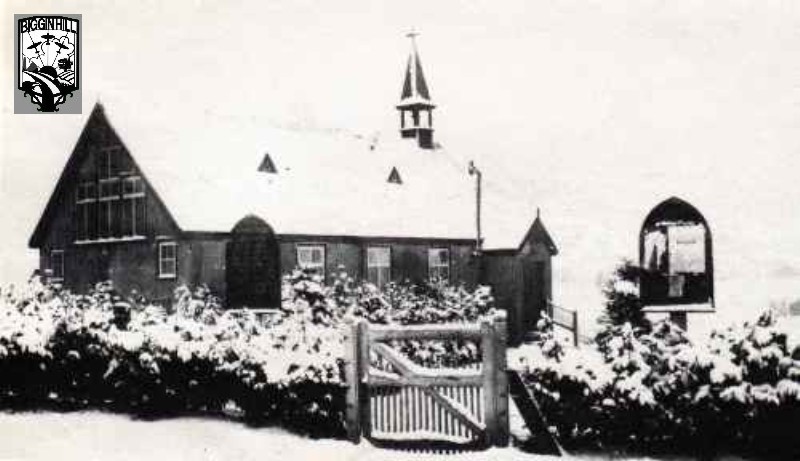History of Biggin Hill
How
it all started
(continued)
(By John Nelson. Taken from the book "Grandfather's Biggin Hill".)
|
Return
to History - Part 1
The first public hall A strong community spirit soon began to emerge among the permanent residents of Biggin Hill, but to begin with there was no public hall which could be used as a focal point for their activities. The first hall to serve as a meeting place for use on social occasions came early in 1903 when The Beacon Concert Hall was opened by Mr. Francis J. Vant, proprietor of The Beacon Refreshment Rooms. It measured thirty feet by fifty feet and was built well back towards Sutherland Avenue on land to the rear of what is now 156 Main Road (Furlongs). The hall fell into disuse in the late 1930's, but as a wartime drill hall for the Home Guard, it again proved its usefulness. Soon after the war, just as it was being converted into a cinema, the hall caught fire late one evening and in no time burned to the ground. A public meeting, the first to be held in
'Mr. Vant's New Room', took place on 27th February 1903, presided over by the
Vicar of Cudham, the Rev. H. A. Curtis; its purpose was 'to consider whether
some further provision could be made for the spiritual needs of Biggin Hill'.
Clearly, the long walk to Cudham Church each Sunday was too much for all but
the most robust of the faithful. Illness prevented the attendance of Mr.
Dougal, but a letter from him was read, offering to donate a site for a
Mission Church at the corner of The Main Road and Polesteeple Hill (now
Temple Road), together with the sum of £25 towards building costs. Mr.
A. C. Norman, the owner of Norheads, agreed to contribute a similar sum and
there were other promises of financial support. A committee was formed and a
resolution passed to the effect that a Mission Church should be erected in
Biggin Hill.
St. Mark's Within less than a year, the Church of St.
Mark was built on the site given by Mr. Dougal at a cost of £230, and
the service of dedication by the Lord Bishop of Dover took place in the
Church on 21st January 1904. The Church was described at the time as a temporary
structure and that, whenever the district had sufficiently developed, it was
intended to erect a permanent brick or stone building. The temporary church,
in fact, remained in use for the next fifty years. The collection at the
dedication service amounting to £5 4s. 21/2d., was applied towards the
building expenses and the Rev. T. Gwynne Davies was appointed the first
Curate-in-Charge. He did not, however, stay long, in common with most of the
other Curates in the early days of St. Mark's.
Early on the morning of Wednesday, 13th July 1904, Mr. F. H. Dougal was found dead in his bed at 148 Merton Road, Wandsworth. He had been ailing for some time, having suffered from heart disease and dropsy, and he had been greatly affected by the loss of his wife about six months previously. His death, however, at the early age of fifty-four, came as a considerable shock. Only the week before, he had been at Aperfield attending to prospective purchasers, and had been in quite good spirits. His funeral was at Wandsworth Cemetery on 15th July and those present included the Rev. H. A. Curtis, Vicar of Cudham, Mr. Freeman who was one of the executors, Jesse Terry, Francis Vant and Mr. D. B. Milbank. Clearly Dougal had been something of an autocrat and the successful start to the marketing of the Aperfield Court Estate had been largely attributed to his own personality and enthusiasm. There was no way in which he could be replaced by executors and trustees obliged to act on the cautious advice of solicitors. The impetus was gone, and within a short while the Daimler passenger service had been withdrawn. Jesse Terry continued to act as agent for the executors but by now he was sixty and no doubt beginning to find climbing the hills all around him more than he could manage. Before long, Mr. D. B. Milbank, who had moved into 'The Mill House', began to undertake some of the duties of the managing agent and together they carried on for the trustees the enterprise which Dougal had initiated. It was well after the First World War
before the trustees offered for sale the land to the east of the Main Road,
opening up Allenby and Haig Roads, named after two of the great soldiers of
the War. Restrictive covenants were, however, placed on this land which had
not been imposed elsewhere on the Estate. One of these required that no
trade, business or manufacture should be carried out upon any plot. Thus the
village was saddled with having a main thoroughfare with all its shops strung
out along one side and none on the other.
For years Biggin Hill never really prospered; it was an embarrassment and a problem so far as the centers of local government in Bromley and Orpington were concerned, and yet there was never stagnation nor lack of support for local tradesmen or for a wide variety of village organisations and activities. Fredrick Henry Dougal's predictions about
the profits to be made from investment in his land eventually came true as
well, but not until long after most of the original purchasers had ceased to
care.
Back
to Choices
|
